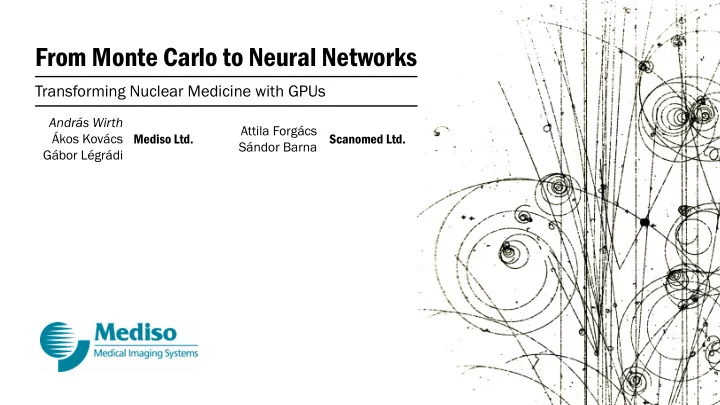

From Monte Carlo to Neural Networks Transforming Nuclear Medicine with GPUs András Wirth Attila Forgács Ákos Kovács Mediso Ltd. Scanomed Ltd. Sándor Barna Gábor Légrádi
Mediso Product Lines 2 Clinical Products Manufacturing Preclinical (“Small Animal”) Products Service HW Development SW Development Software Products
Mediso GPU Usage 3 Latest ASUS midrange Nvidia Geforces Display (OpenGL) Installed base: from 640s to 1060s Development Tool Reconstruction WS Latest ASUS high-end Nvidia Geforces + (CUDA, TensorFlow) Installed base: from GTX 580s to 2080s Product Component HPC Servers Supermicro 4028GR-TRT / TRT2 (CUDA, TensorFlow) (8 / 10 GPUs)
Imaging in Nuclear Medicine 4 Gastroenterology Pulmonology Cardiology Nuclear Nephrology Neurology Medicine Oncology Endocrinology Osteology Exocrinology
Imaging in Nuclear Medicine 5 SPECT detector Electronics PMTs Scintillator Collimator PET CT SPECT Triple-Modality AnyScan SPECT/CT/PET
Imaging in Nuclear Medicine 6 Imaging the 3D radioactivity distribution by detecting gamma photons Repeating measurement from different angles around the patient Alternative way of projecting the distribution onto the gamma camera Reconstruction: calculate 3D distribution data from 2D with multiple pinholes projections
Iterative Reconstruction 7 Forward Projection (Simulation) Gradually approximates the radioisotope distribution Assumed Simulated Ray Tracing Monte Carlo distribution detector signal Accuracy of Forward Projection Back projection is crucial (Comparison with measurement, modifying Physical processes has to be assumed distribution) modelled precisely Time constraint makes reconstruction dependent on Physical Measured Real distribution computational performance processes detector signal Parallelization of transport algorithms on GPU makes using Monte Carlo possible Scatter, absorption Detector response Artifacts
Monte Carlo Particle Transport on GPUs 8 Simulating single particle trajectory 1. Sampling source distribution Body 2. Simulating photon interactions with: collimation body tissues detector material 3. Registering counts in image matrix Collimation Photon trajectories are independent: Each photon can be simulated on a single GPU thread PMT PMT PMT Problem: Detector Photon trajectories are random, threads can diverge Electronics
Iterative Reconstruction 9 Results of forward projections during the reconstruction of a bone SPECT Iteration: 1 5 10 15 20 25 30 35
Iterative Reconstruction 10 Benefits of Monte Carlo Superior resolution Lower scatter background Free of penetration background Can handle multiple isotopes Absolute quantitation: activity in Bq/ml or SUV Conventional 2D Monte Carlo based reconstruction 3D iterative reconstruction
Noise Reduction 11 Development goals in nuclear medicine: Shorter examination time Lower amounts of radioisotope Higher throughput Reduced radiation dose Increased patient comfort Decreased costs Reduced movement artifacts Decreased image statistics Higher noise levels Development of noise reduction methods
Noise Reduction of Planar Bone Scintigraphy 12 Effect of reducing scan time on image quality: 1/4 stats: original 1/2 1/8 1/16 1/32
Neural Network Architecture 13 Original U-Net architecture:
Neural Network Architecture 14 Following candidate architectures were implemented in TensorFlow: U-net adapted to current problem Half U-net Shortcut U-net Fork-net
Neural Network Strategy 15 Training: 1000 anonymized patient scan with standard statistics Images with degraded statistics was generated from the original acquisitions using random binomial sampling Degraded images was used as the input and the corresponding original image as the desired output Evaluation: 128 x 128 patches randomly selected Visual evaluation L1 (maximum value) loss was used Quantitative analysis of image quality based on artificially generated lesions Learning rate: Preliminary clinical test performed on 30 patients (lesion evaluation blind test) Gradually decreased as 1/(1+C*iterations) Through 400 epochs learning rate Performance (4 x GTX 1080 Ti): decreased one order of magnitude Training time: 30 sec / epoch Inference time: 0.08 sec
Evaluation — Visual Examples 16 unfiltered filtered unfiltered filtered unfiltered filtered Stats: original 1/2 1/4
Evaluation — Visual Examples 17 unfiltered filtered unfiltered filtered unfiltered filtered Stats: 1/8 1/16 1/32
Evaluation — Visual Examples 18 unfiltered filtered unfiltered filtered unfiltered filtered Stats: original 1/2 1/4
Evaluation — Visual Examples 19 unfiltered filtered unfiltered filtered unfiltered filtered stats: 1/8 1/16 1/32
Evaluation — Epochs 20 Quality of filtered images degraded to 1/16 statistics as a function of epochs Original Epoch 1 Epoch 5 Epoch 20 Epoch 100 Epoch 1200
Evaluation — Distance Metrics 21 Difference images between the inferred images and the original Difference: std rms rms - std std rms rms - std Stats: 1/8 1/16
Evaluation — Lesion Generation 22 Difference images between the inferred images and the original Various quantitative results, e.g.: Contrast recovery Lesion intensity Gaussian AI Median L2 distance Lesion intensity Original image Bone mask Generated lesions
Evaluation — Preliminary Clinical Test 23 Preliminary clinical test was performed on 30 patient acquisitions (retrospective study). From each original image, three additional images were generated with the following steps: 1 / 2 2. Filter images with NN 3. Increase noise level according to original image 1. Degrade image to 1 / 4 1 / 8 Noise level of the resulting images are indistinguishable Source of a given image cannot be easily guessed Images were evaluated with a blind test Lesions were localized and labeled into 6 categories injection point / bladder / kidney / low risk / medium risk / high risk Labels from the degraded images were compared with the labels from the original patient scan False / True positives and negatives were counted on each image Anterior Posterior
Evaluation — Preliminary Clinical Test 24 A statistical analysis was performed on the lesions found on the different image types. No significant difference was found between the original, the ½ and the ¼ statistics. 1/8 statistics show significant difference in lesion detection. “Usual” challenges of clinical evaluation: intra/inter-operator variability
Recommend
More recommend